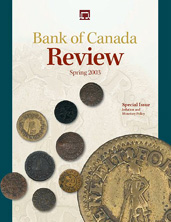Spring 2003

|
The Bank of Canada: Moving Towards Transparency by John Chant
Inflation Targeting and Medium-Term Planning: Some Simple Rules of Thumb
Conference Summary: Price Adjustment and Monetary Policy
Updating the Bank of Canada Commodity Price Index
See also: Tables A1, A2, and Notes to the Tables |
Cover: Seventeenth-Century English Tradesmen's Tokens
In the past, when governments were unable to provide their citizens with an adequate supply of currency, merchants often took matters into their own hands. In pre-Confederation Canada, the lack of a circulating currency prompted the creation of various substitutes, ranging from playing cards in New France to soldiers' buttons in Montréal. In England, merchants and tradesmen issued tokens when the government was unable to supply small-denomination coins.
English merchant guilds and companies began issuing tokens about 1500 to make change for purchases worth less than a penny, or where fractional charges were incurred. Made of lead, the first tokens were small, with a simple design that was often just a series of lines or, occasionally, a group of letters. Contemporary sources report that by 1600 there were more than 3,000 different varieties circulating in London, despite laws to the contrary.
At the beginning of the seventeenth century, the British government attempted to address the problem by introducing copper farthings or quarter-penny pieces. The issue was unsuccessful for several reasons: it was widely counterfeited, it was not evenly distributed throughout the country, and the pieces were of varying weights. Thus, private tokens continued to be issued until the end of the Civil War in 1649. With the death of King Charles I and the apparent removal of the royal prerogative to mint money, merchants and municipal corporations across England became even bolder. A flood of tokens like those on the front cover were issued, including farthing, halfpenny, and penny tokens. Made of brass or copper, they carried denominations, a variety of designs, and even the merchants' names and those of their businesses. Almost every type of merchant is represented, among them: coffee houses, taverns, fishmongers, hatters, glovers, apothecaries, carriers, saddlers, ferrymen, grocers, cheesemongers, butchers, bakers, chandlers, shoemakers, locksmiths, potters, and booksellers.
With the restoration of the monarchy in 1660, laws were again passed prohibiting the issue of private tokens, to little effect. Aware of the hardship posed by the absence of an official issue of low-denomination copper coins, the government did not prosecute offenders—merchants charged with the offence of issuing tokens were typically released on a promise to refrain from the practice. In 1672, however, the government began issuing its own farthing and halfpenny coins. With suitable coins in circulation, the government renewed its efforts to prosecute offenders, and the issuance of merchant tokens had largely ceased by 1674.
The tokens pictured on the cover are part of the National Currency Collection.
Photographed by Gord Carter, Ottawa.




